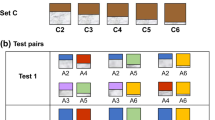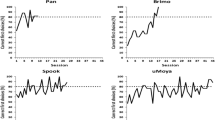Abstract
Relational learning, as opposed to perceptual learning, is based on the abstract properties of the stimuli. Although at present there is no doubt that pigeons are capable of relational behavior, this study aims to further disclose the conditions under which it occurs. Pigeons were trained in an outdoor cage on a matching-to-sample or an oddity-from-sample task, with colored cardboard stimuli presented horizontally. The apparatus involved three sliding lids on which the stimuli were drawn and which, when displaced, revealed the reinforcement. The lids were either adjacent to each other or somewhat separated. Training sessions involved two colors, and test sessions six different colors (same dimension test), or six different shapes (different dimension test). One group of birds trained under the ‘adjacent’ condition failed when tested with new stimuli, but succeeded in both dimension tests after training under the ‘separate’ condition. Two other groups of birds succeeded in all tests after training under the latter condition. These results show that depending on procedural details, pigeons are or are not able to transfer from one visual dimension to another, thus extending previous related findings.




Similar content being viewed by others
References
Blough DS (1982) Pigeon perception of letters of the alphabet. Science 218:397–398
Carter DE, Werner TJ (1978) Complex learning and information processing by pigeons: a critical analysis. J Exp Anal Behav 29:565–601
Cerella J (1980) The pigeon’s analysis of pictures. Pattern Recogn 12:1–6
Cook RG (2002) The structure of pigeon multiple-class same-different learning. J Exp Anal Behav 78:345–364
Cook RG, Katz JS, Cavoto BR (1997) Pigeon same-different concept learning with multiple stimulus classes. J Exp Psychol Anim Behav Proc 23:417–433
Cumming WW, Berryman R (1961) Some data on matching behavior in the pigeon. J Exp Anal Behav 4:281–284
Cumming WW, Berryman R, Cohen LR (1965) Acquisition and transfer of zero delay matching. Psychol Rep 17:435–445
Delius JD (1968) Colour preference shift in hungry and thirsty pigeons. Psychon Sci 13:273–274
Delius JD (1992) Categorical discrimination of objects and pictures by pigeons. Anim Learn Behav 20:301–311
Delius JD (1994) Comparative cognition of identity. In: Bertelson P, Eelen P, d’Ydewalle G (eds) International perspectives on psychological science. LEA, Hillsdale, pp 25–40
Delius JD, von Fersen L (1996) Gedächtnis bei Tieren. In: Albert D, Stapf KH (eds) Gedächtnis, Enzyklopädie der Psychologie. Hogrefe, Göttingen, pp 489–539
Delius JD, Nowak B (1982) Visual symmetry recognition by pigeons. Psychol Res 44:199–212
Delius JD, Siemann M, Emmerton J, Xia L (1999) Cognitions of birds as products of evolved brains. In: Roth G, Wullimann MF (eds) Brain evolution and cognition. Spektrum, Heidelberg, pp 451–490
Delius JD, Emmerton J, Hörster W, Jäger R, Ostheim J (1999) Picture-object recognition in pigeons. Curr Psychol Cogn 18:621–656
Emmerton J (1983) Vision. In: Abs M (ed) Physiology and behaviour of the pigeon. Academic, London, pp 245–266
Farthing GW, Opuda MJ (1974) Transfer of matching-to-sample in pigeons. J Exp Anal Behav 21:199–213
Herrnstein RJ, Loveland DH (1964) Complex visual concept in the pigeon. Science 146:549–551
Herrnstein RJ, Loveland DH, Cable C (1976) Natural concepts in pigeons. J Exp Psychol Anim Behav Proc 2:285–302
Holmes PW (1979) Transfer of matching performance in pigeons. J Exp Anal Behav 31:103–114
Katz JS, Wright AA (2006) Same/different abstract concept learning by pigeons. J Exp Psychol Anim Behav Proc 32:80–86
Katz JS, Wright AA, Bachevalier J (2002) Mechanisms of same/different abstract-concept learning by rhesus monkeys (Macaca mulatta). J Exp Psychol Anim Behav Proc 28:358–368
Khallad Y (2004) Conceptualization in the pigeon: what do we know? Int J Psychol 39:73–94
Lea SEG (1984) In what sense do pigeons learn concepts? In: Roitblat HL, Terrace HS (eds) Animal cognition. LEA, Hillsdale, pp 263–276
Lea SEG, Goto K, Osthaus B, Ryan CME (2006) The logic of the stimulus. Anim Cogn 9:247–256. doi:10.1007/s10071-006-0038-3
Lombardi CM, Delius JD (1988) Pattern recognition invariance in pigeons (Columba livia): outline, color and contrast. Int J Comp Psychol 2:83–102
Lombardi CM, Fachinelli CC, Delius JD (1984) Oddity of visual patterns conceptualized by pigeons. Anim Learn Behav 12:2–6
Mandler JM (2004) Thought before language. Trends Cogn Sci 8:508–513
Martin TI, Zentall TR (2005) Post-choice information processing by pigeons. Anim Cogn 8:273–278. doi:10.1007/s 10071-005-0254-2
Morgan MJ, Fitch MD, Holman MD, Lea SEG (1976) Pigeons learn the concept of an ‘A’. Perception 5:57–66
Oden DL, Thompson RKR, Premack D (1988) Spontaneous transfer of matching by infant chimpanzees (Pan troglodytes). J Exp Psychol Anim Behav Proc 14:140–145
Pepperberg IM (1987) Acquisition of the same/different concept by an African grey parrot (Psittacus erithacus): learning with respect to categories of color, shape, and material. Anim Learn Behav 15:423–432
Pepperberg IM (1999) The Alex studies. Harvard University Press, Cambridge, chap. 5
Pisacreta R, Redwood E, Witt K (1984) Transfer of matching-to-figure samples in the pigeon. J Exp Anal Behav 42:223–237
Pisacreta R, Witt K (1983) Same-different discriminations in the pigeons. Bull Psychon Soc 21:411–414
Porter D, Neuringer A (1984) Music discriminations by pigeons. J Exp Psychol Anim Behav Proc 10:138–148
Premack D (1978) On the abstractness of human concepts: why it would be difficult to talk to a pigeon. In: Hulse SH, Fowler H, Honig WK (eds) Cognitive processes in animal behavior. Erlbaum, Hillsdale, pp 423–451
Premack D (1983) The codes of man and beasts. Behav Br Sci 6:125–167
Roitberg E, Franz H (2004) Oddity learning by African dwarf goats (Capra hircus). Anim Cogn 7:61–67. doi:10.1007/s1007-003-0190-y
Roitblat HL, von Fersen L (1992) Comparative cognition: representations and processes in learning and memory. Ann Rev Psychol 43:671–710
Ryan CME, Lea SEG (1994) Images of conspecifics as categories to be discriminated by pigeons and chickens: slides, video tapes, stuffed birds and live birds. Behav Proc 33:155–176
Santi A (1982) Hue matching and hue oddity by pigeons: is explicit training not to peck incorrect hue combinations a sufficient condition for transfer? Psychol Rec 32:61–73
Santiago HC, Wright AA (1984) Pigeon memory: same/different concept learning, serial probe recognition acquisition, and probe delay effects on the serial-position function. J Exp Psychol Anim Behav Proc 10:498–512
Siegel RK, Honig WK (1970) Pigeon concept formation: successive and simultaneous acquisition. Exp Anal Behav 13:385–390
Siemann M, von Fersen L, Delius JD (1998) Kognition bei Tieren. In: Irle E, Markowitsch HJ (eds) Vergleichende Psychobiologie, Enzyklopädie der Psychologie. Hogrefe, Göttingen, pp 695–738
Smirnova AA, Lazareva OF, Zorina ZA (2000) Use of number by crows: investigation by matching and oddity learning. J Exp Anal Behav 73:163–176
Thomas RK (1980) Evolution of intelligence: an approach to its assessment. Brain Behav Evol 17:454–472
Urcuioli PJ, Nevin JA (1975) Transfer of the hue matching in pigeons. J Exp Anal Behav 24:149–155
Wasserman EA, Hugart JA, Kirkpatrick-Steger K (1995) Pigeons show same-different conceptualization after training with complex visual stimuli. J Exp Psychol Anim Behav Proc 21:248–252
Wilson B, Mackintosh NJ, Boakes RA (1985) Transfer of relational rules in matching and oddity learning by pigeons and corvids. Q J Exp Psychol 37(B):313–332
Wright AA (1997) Concept learning and learning strategies. Psychol Sci 8:119–123
Wright AA (2001) Learning strategies in matching to sample. In Cook RG (ed) Avian visual cognition [On-line]. Available: www.pigeon.psy.tufts.edu/avc/akins/
Wright AA, Cook RG, Kendrick DF (1989) Relational and absolute stimulus learning by monkeys in a memory task. J Exp Anal Behav 52:237–248
Wright AA, Cook RG, Rivera JJ, Sands SF, Delius JD (1988) Concept learning by pigeons: matching-to-sample with trial-unique video picture stimuli. Anim Learn Behav 16:436–444
Wright AA, Delius JD (1994) Scratch & match: pigeons learn matching and oddity with gravel stimuli. J Exp Psychol Anim Behav Proc 20:108–112
Wright AA, Delius JD (2005) Learning processes in matching and oddity: the oddity preference effect and sample reinforcement. J Exp Psychol Anim Behav Proc 31:425–432
Wright AA, Rivera JJ, Katz JS, Bachevalier J (2003) Abstract-concept learning and list-memory processing by capuchin and rhesus monkeys. J Exp Psychol Anim Behav Proc 29:184–198
Zentall TR, Galizio M, Critchfield TS (2002) Categorization, concept learning, and behavior analysis: an introduction. J Exp Anal Behav 78:237–248
Zentall TR, Hogan DE (1974) Abstract concept learning in the pigeon. J Exp Psychol 102:393–398
Zentall TR, Hogan DE (1976) Pigeons can learn identity or difference, or both. Science 191:408–409
Zentall TR, Hogan DE (1978) Same/different concept learning in the pigeon: the effect of negative instances and prior adaptation to transfer stimuli. J Exp Anal Behav 30:177–186
Acknowledgements
I am grateful to J. D. Delius, A. A. Wright, S. H. Hurlbert, T. Czeschlik (chief editor of ‘Animal Cognition’), and three anonymous reviewers for useful suggestions on the manuscript, to M. C. Etchichury for facilitating the precise measurement of the grains, and to M. Aramburu, M. Cirulo, L. Giachetti, E. Gulin, G. Kamm, C. Kobashigawa, M. Ré, N. Smud and E. Vera for their cooperation and assistance. I thank C. Le Cornu for improving the English. The experiments comply with the Argentine current laws.
Author information
Authors and Affiliations
Corresponding author
Rights and permissions
About this article
Cite this article
Lombardi, C.M. Matching and oddity relational learning by pigeons (Columba livia): transfer from color to shape. Anim Cogn 11, 67–74 (2008). https://doi.org/10.1007/s10071-007-0087-2
Received:
Revised:
Accepted:
Published:
Issue Date:
DOI: https://doi.org/10.1007/s10071-007-0087-2




